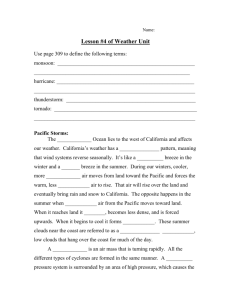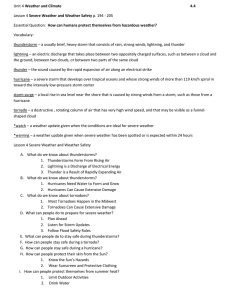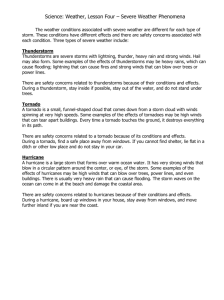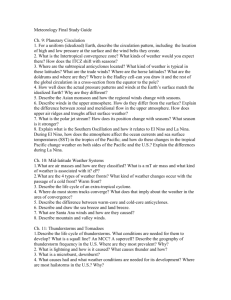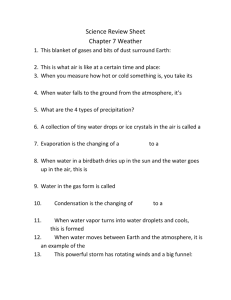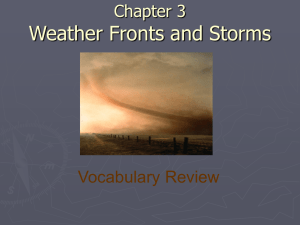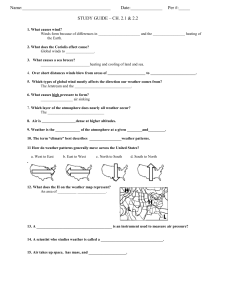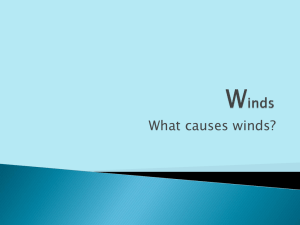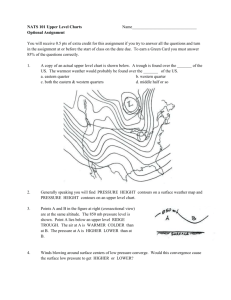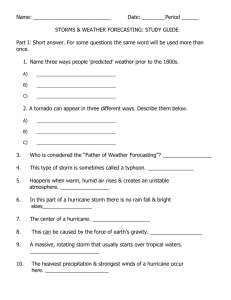21111 Instructor: Prof. Seiberling PHYSICS DEPARTMENT MET 1010
advertisement
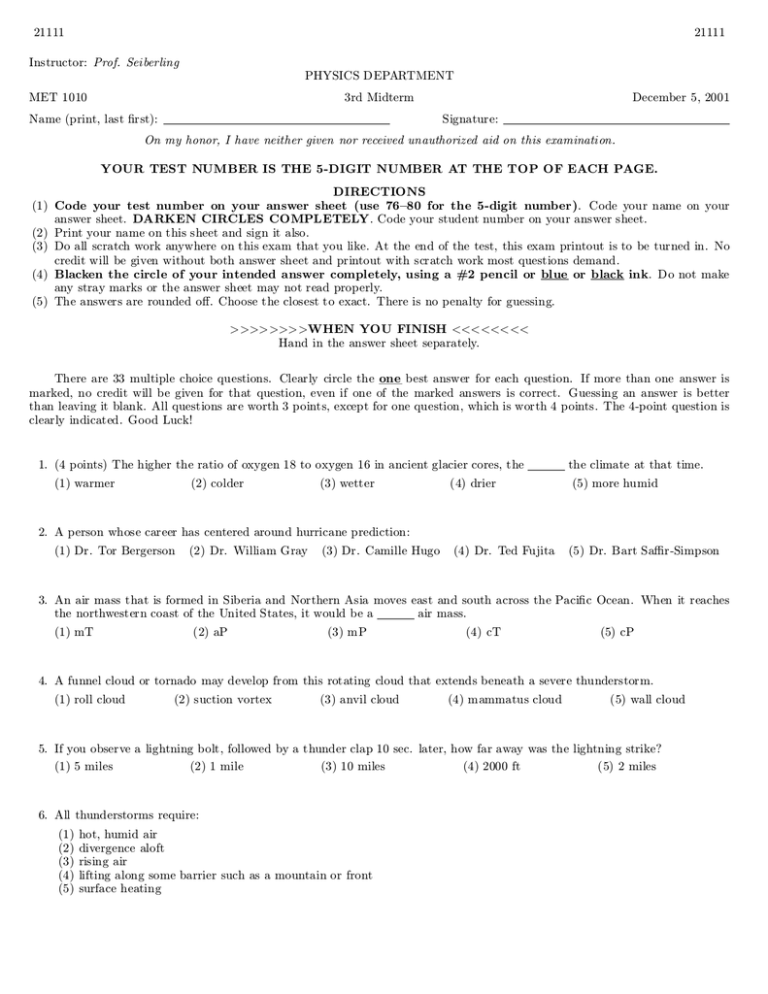
21111
21111
Instructor: Prof. Seiberling
PHYSICS DEPARTMENT
MET 1010
3rd Midterm
Name (print, last ¯rst):
December 5, 2001
Signature:
On my honor, I have neither given nor received unauthorized aid on this examination.
YOUR TEST NUMBER IS THE 5-DIGIT NUMBER AT THE TOP OF EACH PAGE.
DIRECTIONS
(1) Code your test number on your answer sheet (use 76{80 for the 5-digit number). Code your name on your
answer sheet. DARKEN CIRCLES COMPLETELY. Code your student number on your answer sheet.
(2) Print your name on this sheet and sign it also.
(3) Do all scratch work anywhere on this exam that you like. At the end of the test, this exam printout is to be turned in. No
credit will be given without both answer sheet and printout with scratch work most questions demand.
(4) Blacken the circle of your intended answer completely, using a #2 pencil or blue or black ink. Do not make
any stray marks or the answer sheet may not read properly.
(5) The answers are rounded o®. Choose the closest to exact. There is no penalty for guessing.
>>>>>>>>WHEN YOU FINISH <<<<<<<<
Hand in the answer sheet separately.
There are 33 multiple choice questions. Clearly circle the one best answer for each question. If more than one answer is
marked, no credit will be given for that question, even if one of the marked answers is correct. Guessing an answer is better
than leaving it blank. All questions are worth 3 points, except for one question, which is worth 4 points. The 4-point question is
clearly indicated. Good Luck!
1. (4 points) The higher the ratio of oxygen 18 to oxygen 16 in ancient glacier cores, the
(1) warmer
(2) colder
(3) wetter
(4) drier
the climate at that time.
(5) more humid
2. A person whose career has centered around hurricane prediction:
(1) Dr. Tor Bergerson
(2) Dr. William Gray
(3) Dr. Camille Hugo
(4) Dr. Ted Fujita
(5) Dr. Bart Sa±r-Simpson
3. An air mass that is formed in Siberia and Northern Asia moves east and south across the Paci¯c Ocean. When it reaches
the northwestern coast of the United States, it would be a
air mass.
(1) mT
(2) aP
(3) mP
(4) cT
(5) cP
4. A funnel cloud or tornado may develop from this rotating cloud that extends beneath a severe thunderstorm.
(1) roll cloud
(2) suction vortex
(3) anvil cloud
(4) mammatus cloud
(5) wall cloud
5. If you observe a lightning bolt, followed by a thunder clap 10 sec. later, how far away was the lightning strike?
(1) 5 miles
(2) 1 mile
(3) 10 miles
(4) 2000 ft
(5) 2 miles
6. All thunderstorms require:
(1)
(2)
(3)
(4)
(5)
hot, humid air
divergence aloft
rising air
lifting along some barrier such as a mountain or front
surface heating
21111
21111
7. The Planetary Vorticity of an air parcel moving from low toward high latitude in the Northern Hemisphere will:
(1) increase
(2) change from negative to positive
(3) decrease
(4) remain constant
(5) change from positive to negative
8. An example of ensemble forecasting is:
(1)
(2)
(3)
(4)
(5)
predicting the same weather today as occurred yesterday
comparing present conditions with similar conditions in the past
asking several di®erent meteorologists what the forecast will be
running several forecast models, each beginning with slightly di®erent weather information
making a forecast based on the climate of several adjacent regions
9. A major hurricane is one that:
(1) has a strong storm surge
(2) is category 3 or higher on the Sa±r-Simpson scale
(3) gets a name
(4) in°icts heavy damage on shore
(5) has winds greater than 74 miles per hour
10. Severe thunderstorms are di®erent from ordinary (or air-mass) thunderstorms in that severe thunderstorms:
(1) have a tilted updraft
(2) have a strong updraft and downdraft
(3) contain thunder and lightning
(4) contain hail
(5) have an anvil
11. Which is NOT true of conditions in the eye of a hurricane?
(1)
(2)
(3)
(4)
(5)
the strongest thunderstorms occur
skies are partly cloudy
air is falling
pressure is lowest
air is warm
12. The piling up of air above a region is called:
(1) cyclogenesis
(2) thickening
(3) cold advection
(4) convergence
(5) divergence
13. If a closed low (a low with at least one contour encircling it) occurs at the 500 mb level directly above a surface low:
(1)
(2)
(3)
(4)
(5)
cold advection will add to the developing storm
the surface low will intensify
upper level divergence will occur
the surface low will ¯ll
a shortwave has passed through the upper-level low
21111
21111
14. The signal detected by a Doppler radar is:
(1) a pulsed radiowave re°ected by precipitation
(2) a soundwave produced by thunder
(3) a continuous radiowave re°ected by precipitation
(4) a soundwave produced by wind shear
(5) a radiowave emitted by lightning
15. If conditions are Barotropic on an upper- level chart:
(1)
(2)
(3)
(4)
(5)
winds are not geostrophic
cold advection occurs
a lee side low has formed
isotherms parallel contours
rising and descending air motions exist
16. Which of the following occurs as a cold front passes, but not as a gust front passes?
(1) the pressure rises after the front passes
(2) the relative humidity drops after the front passes
(3) the winds become gusty
(4) the winds shift direction
(5) the temperature drops
17. What weather would be forecast based on the following observations? Surface winds from the SE, cool conditions, high
clouds thickening and lowering.
(1) clearing and continued cool
(2) showers likely to develop, turning colder
(3) thunderstorms building in the next few hours, continued cool
(4) steady, light rain beginning within 24 hours, turning cold
(5) steady, light rain beginning within 24 hours, turning warmer
18. The average temperature of the earth's surface 20,000 years ago was:
(1)
(2)
(3)
(4)
(5)
much less variable from year to year than present
warmer than present
about the same as present
colder than present
much more variable from year to year than present
19. Climate change associated with the length of the solar magnetic cycle is proposed to a®ect climate on a timescale of about:
(1) 250 years
(2) 25,000 years
(3) 250,000 years
(4) 2500 years
(5) 25 years
20. An occluded front occurs when:
(1)
(2)
(3)
(4)
(5)
a
a
a
a
a
strong low pressure system ¯lls
warm front becomes a stationary front
cold front becomes a stationary front
cold front overtakes a warm front
cold front weakens and dissipates
21111
21111
21. Just outside the outermost band of a hurricane moving across the ocean:
(1) skies are cloudy and waves are large
(2) winds are light and the sea is calm
(3) skies are clear and the sea is calm
(4) skies are clear and waves are large
(5) skies are cloudy and the sea is calm
22. The region in the United States with the greatest annual frequency of hailstones is:
(1) Texas
(2) the western great plains
(3) the Mississippi Valley
(4) the Paci¯c Northwest
(5) Florida
23. What condition is NOT related to an intensifying storm?
(1) baroclinic conditions
(2) an occluding front
(3) a shortwave passing through a trough
(4) divergence aloft
(5) zonal °ow aloft
24. The °ag for a hurricane warning is:
(1)
(2)
(3)
(4)
(5)
two red squares, each with a black square inside
two black triangles
one red triangle
two red triangles
one red square with a black square inside
25. This problem and the next 3 problems refer to the Figure. Which line best represents the position of a cold front?
(1) 5
(2) 2
(3) 3
(4) 4
(5) 1
26. Which line best represents the position of a warm front?
(1) 3
(2) 4
(3) 5
(4) 2
(5) 1
27. According to the Figure, which best describes the present weather in Mississippi (labeled MS)?
(1) winds westerly, partly cloudy, cool and dry
(2) winds northerly, clear and cool
(3) winds southerly, partly cloudy skies, warm and humid
(4) winds westerly, cloudy skies, warm and humid
(5) winds southeasterly, rainy and cool
28. According to the Figure, which is the best forecast for Mississippi (labeled MS)? Assume the system is moving to the SE at
20 mph.
(1) winds shifting the northerly, clearing and cold
(2) winds becoming easterly with steady rain and cooler temperatures
(3) winds shifting to westerly, showers and cooler temperatures
(4) not much change in the next few days
(5) winds shifting to southerly, clouds building and warmer
21111
21111
29. One year, in the tropical North Atlantic, tropical storm Fay struck the Windward Islands. Next, a tropical depression
formed near Cuba, then dissipated before reaching tropical storm strength. Next, a tropical wave o® Africa developed into
a category 3 hurricane. What is a possible name for this hurricane?
(1) Greg
(2) Gertrude
(3) Henry
(4) Hanna
(5) Frank
30. For a surface storm system to intensify, the upper-level low (or trough) should be located
(1) to the west of
(2) to the south of
(3) to the east of
(4) to the north of
the surface low.
(5) directly above
31. Which of the following is NOT proposed as a factor in°uencing climate change in the Milankovitch theory?
(1)
(2)
(3)
(4)
(5)
eccentricity of the earth's orbit
changes in the tilt of the earth's axis
periodic reversals of the earth's magnetic ¯eld
changes in the shape of the earth's orbit
precession of the earth's axis
32. In the last 50 years, carbon dioxide (CO 2 ) levels in the atmosphere have risen by about:
(1) 2%
(2) 20%
(3) 0%
(4) 200%
33. A sounding is:
(1) measuring the gravitational constant using sound waves
(2) measuring the distance to a lightning strike using the time lapse for thunder to occur
(3) measuring cloud heights using sonar
(4) a vertical pro¯le of weather elements
(5) determining wind speed using Doppler radar
(5) 100%
21111
21111
